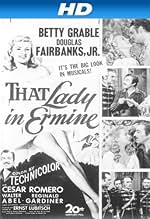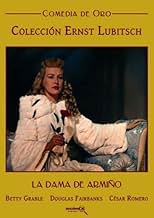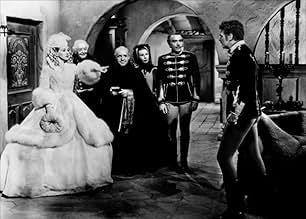Ajouter une intrigue dans votre langueThat Lady in Ermine tells two parallel stories, both taking place in the small Mittel-European duchy of Bergamo, with one set in the 19th century and the other in the 16th.That Lady in Ermine tells two parallel stories, both taking place in the small Mittel-European duchy of Bergamo, with one set in the 19th century and the other in the 16th.That Lady in Ermine tells two parallel stories, both taking place in the small Mittel-European duchy of Bergamo, with one set in the 19th century and the other in the 16th.
- Directors
- Writers
- Stars
- Nommé pour 1 oscar
- 2 nominations au total
Lester Allen
- Jester
- (uncredited)
Mary Bear
- Isabella - Ancestor
- (uncredited)
David Bond
- Gabor
- (uncredited)
Harry Carter
- Staff Officer
- (uncredited)
Harry Cording
- Orlando - Ancestor
- (uncredited)
Herbert Evans
- Ancestor
- (uncredited)
Jack George
- Count Giovanni - Ancestor
- (uncredited)
Don Haggerty
- Staff Officer
- (uncredited)
Joe Haworth
- Soldier
- (uncredited)
Ray Hyke
- Albert's Knight
- (uncredited)
Avis en vedette
I really enjoyed this Lubitsch movie with Betty Grable. It made quite a change from her usual "musicals", and I cannot again understand why there have been no videos or DVDs made of it. Younger viewers who don't even know who Betty Grable is will surely appreciate this Lubitsch movie. Here's hoping!
If you have the opportunity to catch this one on TV (It's in American Movie Classic's library, I believe, and doesn't appear to be available on video.) and you're a fan of Ernst Lubitsch, don't expect much evidence of his famous "Touch." Herr Lubitsch died before completing very much of this production and the directing reigns were turned over to Otto Preminger. Apparently the studio felt that an artist whose ancestral origins shared to some degree those of Mr. Lubitsch was the proper person to complete this project. My own impression of the final results makes the passing of the talented Mr. Lubitsch a great misfortune for all concerned. As I watched it on a TV broadcast several years ago I stared in amazement at what seemed an extraordinarily clumsy and heavy-handed attempt to tell what is, essentially, a fairy story for adults. There are definitely elements to enjoy and Betty Grable is, as always, appealingly lovely in Technicolor and has a lively and natural presence as an actress. But Mr. Preminger's reputation, without later critically praised films, such as "Anatomy of a Murder," was not greatly enhanced by the final cut of this film.
Ernst Lubitsch's style permeates this unjustly forgotten movie, from a different age of cinema. Oddly enough, any old film noir (or just crime-oriented) feature from its age is revered on a pedestal today, while this wonderful 20th Century-Fox big-budget effort stirs little interest.
It is a remake of a 1927 silent film of the same title, a Corinne Griffith star vehicle from First National Pictures, the distributor that later became part of Warner Brothers. It's a lost film, perhaps because a silent movie of an operetta was hopelessly dated even then. Lubitsch includes fantasy and satire here, with the play-acting performances of stars Grable and Fairbanks delightful in that they make fun of the antiquated Period Costume Film cliches, while simultaneously creating warm and empathetic characters. The elements of satire have given way in modern cinema to vulgarity, as evidenced in the work of Mel Brooks (who remade Lubtisch's hit "To Be Or Not to Be") or my favorite director Ken Russell, yet Lubitsch is able to maintain the high ground even in the silliest of scenes, perhaps aided by the censorship of his day.
The Technicolor photography (by Leon Shamroy) remains stunning and just what any film buff should admire. A couple of oddities struck me as I finally saw this movie, so many decades after release, first the foot-fetish theme that instantly suggests Luis Bunuel, who was working in Hollywood during this period. And by some odd coincidence, the starting point for the movie's fantasy element is the stunning portrait of Gable as a 17th Century ancestor of her main character, which comes to life occasionally. Fairbanks' infatuation with the lady in the portrait is the same starting point as Preminger's greatest movie, "Laura", and Otto ended up completing "Ermine" after Lubitsch's sudden death at the age of 55.
It is a remake of a 1927 silent film of the same title, a Corinne Griffith star vehicle from First National Pictures, the distributor that later became part of Warner Brothers. It's a lost film, perhaps because a silent movie of an operetta was hopelessly dated even then. Lubitsch includes fantasy and satire here, with the play-acting performances of stars Grable and Fairbanks delightful in that they make fun of the antiquated Period Costume Film cliches, while simultaneously creating warm and empathetic characters. The elements of satire have given way in modern cinema to vulgarity, as evidenced in the work of Mel Brooks (who remade Lubtisch's hit "To Be Or Not to Be") or my favorite director Ken Russell, yet Lubitsch is able to maintain the high ground even in the silliest of scenes, perhaps aided by the censorship of his day.
The Technicolor photography (by Leon Shamroy) remains stunning and just what any film buff should admire. A couple of oddities struck me as I finally saw this movie, so many decades after release, first the foot-fetish theme that instantly suggests Luis Bunuel, who was working in Hollywood during this period. And by some odd coincidence, the starting point for the movie's fantasy element is the stunning portrait of Gable as a 17th Century ancestor of her main character, which comes to life occasionally. Fairbanks' infatuation with the lady in the portrait is the same starting point as Preminger's greatest movie, "Laura", and Otto ended up completing "Ermine" after Lubitsch's sudden death at the age of 55.
I just watched this film on YouTube; it's there for free in version with very good image quality. It was a box office flop, and has a poor reputation among classic film devotees. But if you enjoy musicals, you might want to give it a chance.
I mildly enjoyed it. Fairbanks Jr. Is excellent, giving a spirtited performance with the right touch of believable emotion and light tungue in cheek playfulness. The sets are opulant. Fredrick Holander's music is lovely, though the song lyrics (by Leo Robin?) are mediocre and banal. There are occasional playfully funny moments.
On the down side, the film overall lacks the charm, subtle sexiness, and light touch that Lubitch would have given it, if he had directed the entire thing, and his capabilities were not greatly diminished by very poor health. Grable is OK in the role, but far from the ideal actress-singer for it. I've read that Fox head Zanick wanted to broaden her appeal and put her in more high class roles, so she made three classy pictures and all of them, including this one flopped. (One of them is excellent, and I highly recommend it, "The Shocking Miss Pilgrim".)
That Lady in Ermine seems to have two endings; and I felt let down by the second one. It should have ended when the Fairbanks character rides away, bidding the Grable character a regretful goodby. But then there's a entirely unnecessary scene, which seems tacked on.
I mildly enjoyed it. Fairbanks Jr. Is excellent, giving a spirtited performance with the right touch of believable emotion and light tungue in cheek playfulness. The sets are opulant. Fredrick Holander's music is lovely, though the song lyrics (by Leo Robin?) are mediocre and banal. There are occasional playfully funny moments.
On the down side, the film overall lacks the charm, subtle sexiness, and light touch that Lubitch would have given it, if he had directed the entire thing, and his capabilities were not greatly diminished by very poor health. Grable is OK in the role, but far from the ideal actress-singer for it. I've read that Fox head Zanick wanted to broaden her appeal and put her in more high class roles, so she made three classy pictures and all of them, including this one flopped. (One of them is excellent, and I highly recommend it, "The Shocking Miss Pilgrim".)
That Lady in Ermine seems to have two endings; and I felt let down by the second one. It should have ended when the Fairbanks character rides away, bidding the Grable character a regretful goodby. But then there's a entirely unnecessary scene, which seems tacked on.
Betty Grable is "That Lady in Ermine" in this 1948 musical, also starring Douglas Fairbanks, Jr., Cesar Romero, Reginald Gardner, and Walter Abel.
Frankly, it's hard for me to believe that Lubitsch directed this. And in fact, he died eight days into production and the film was finished by Otto Preminger. The story is taken from a 1922 musical, and originally Lubitsch wanted Jeanette MacDonald for the role; Zanuck wanted Gene Tierney; finally Irene Dunne and Charles Boyer were announced, but it didn't happen.
Grable has a dual role here, as Angelina in 1861 and her ancestor Francesca, from 1561, whose portrait hangs in the great hall. Angelina has just been married to Count Mario, who, as soon as they get into her quarters, is called to action against Hungarian invaders. The Hungarians also invaded 300 years ago, and Francesca was able to save the castle. Can her ancestor do it again, in spite of feeling attracted to the handsome colonel (Douglas Fairbanks Jr.)? The film takes us into the past and back into the present, and it's a lush, gorgeous production. Grable's gowns are exquisite, and she looks gorgeous. Someone here noted she was past her prime (at the ripe old age of 31) and a little plump. She sure didn't look it to me, she looks fantastic. The color in the film is eye-popping as well.
There is really no music to speak of, except for a couple of songs that are continually repeated. There are some funny bits, and it's a fine cast. The ancestors step out of their portraits and come to life, and at one point, Fairbanks is dubbed and sings gloriously in an operatic tenor voice. Fairbanks is wonderful; Grable is perhaps a little too vanilla for the role, but she gives the role a youthful energy. Other than Tierney, the other stars, who were legit sopranos, were a bit older. The story, what there was of it, really needed the lightness Grable gave it.
See it for incredible color and costumes and a fine cast. The music and the story aren't of much consequence - it's nice postwar fluff.
Frankly, it's hard for me to believe that Lubitsch directed this. And in fact, he died eight days into production and the film was finished by Otto Preminger. The story is taken from a 1922 musical, and originally Lubitsch wanted Jeanette MacDonald for the role; Zanuck wanted Gene Tierney; finally Irene Dunne and Charles Boyer were announced, but it didn't happen.
Grable has a dual role here, as Angelina in 1861 and her ancestor Francesca, from 1561, whose portrait hangs in the great hall. Angelina has just been married to Count Mario, who, as soon as they get into her quarters, is called to action against Hungarian invaders. The Hungarians also invaded 300 years ago, and Francesca was able to save the castle. Can her ancestor do it again, in spite of feeling attracted to the handsome colonel (Douglas Fairbanks Jr.)? The film takes us into the past and back into the present, and it's a lush, gorgeous production. Grable's gowns are exquisite, and she looks gorgeous. Someone here noted she was past her prime (at the ripe old age of 31) and a little plump. She sure didn't look it to me, she looks fantastic. The color in the film is eye-popping as well.
There is really no music to speak of, except for a couple of songs that are continually repeated. There are some funny bits, and it's a fine cast. The ancestors step out of their portraits and come to life, and at one point, Fairbanks is dubbed and sings gloriously in an operatic tenor voice. Fairbanks is wonderful; Grable is perhaps a little too vanilla for the role, but she gives the role a youthful energy. Other than Tierney, the other stars, who were legit sopranos, were a bit older. The story, what there was of it, really needed the lightness Grable gave it.
See it for incredible color and costumes and a fine cast. The music and the story aren't of much consequence - it's nice postwar fluff.
Le saviez-vous
- AnecdotesIn later years Betty Grable said it was her least favorite of all her movies.
- GaffesIf you watch when the Lady in Ermine is dancing with Colonel Ladislas Karolyi Teglas / The Duke her shoes change from the heels to wedges.
- Citations
Col. Ladislas Karolyi Teglas: If one is in love, one doesn't need an umbrella.
- ConnexionsFeatured in The Costume Designer (1950)
- Bandes originalesOoh! What I'll Do (To That Wild Hungarian)
(uncredited)
Written by Friedrich Hollaender
Lyrics Leo Robin
Sung by Betty Grable and chorus
Danced by Betty Grable and Douglas Fairbanks Jr.
Meilleurs choix
Connectez-vous pour évaluer et surveiller les recommandations personnalisées
- How long is That Lady in Ermine?Propulsé par Alexa
Détails
Box-office
- Budget
- 2 484 000 $ US (estimation)
- Durée1 heure 29 minutes
- Couleur
- Rapport de forme
- 1.37 : 1
Contribuer à cette page
Suggérer une modification ou ajouter du contenu manquant

Lacune principale
By what name was That Lady in Ermine (1948) officially released in India in English?
Répondre
































